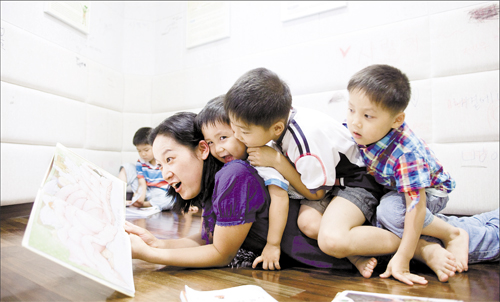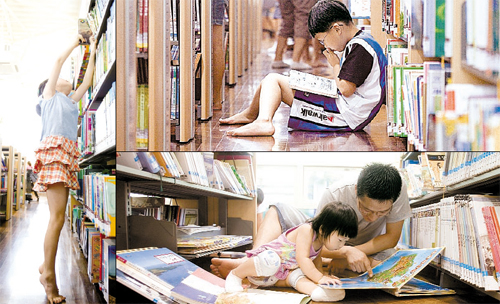A place where flowers and children bloom

The Jecheon Miracle Library was established using money from a 2003 campaign promoted by the TV show “Exclamation,” MBC’s popular program about books.
In support of the National Movement for a Book-reading Society, the program received many donations and the funds were used to construct 11 Miracle Libraries across the nation.
The Jecheon branch, which opened in 2003, has become a model for public libraries, including the National Museum of Korea, which wants to benchmark the system.
When visitors arrive at the library they tend to be surprised by the sound of children. To keep children interested in reading, Miracle Libraries make the place as enjoyable as possible.
However, the most unique aspect of the library is its management. The local government provides financing, but management of the facility is in the hands of the town’s people, and volunteer specialists host hundreds of programs.
Thanks to these volunteers, many children with poor reading skills have become proficient readers.
Because of the library a child called Ho-dung, who couldn’t make eye contact with others, is now a cheerful boy with many friends. This change happened after his mother bought him to the library. Some mothers turn into volunteers themselves, deeply touched by their children’s improvement. Age doesn’t seem to factor for the corps of volunteers. For example, older elementary school students regularly read short stories to the little babies of working mothers.

Children at the Jecheon library can pursue a range of activities as they play with their mothers or other volunteers.
Children are captivated whenever 72-year-old storyteller Lee Tae-yeong begins to tell a tale. Lee is a member of Tiger’s Piper, a group of storytelling senior citizens, and he works as a volunteer storyteller at Jecheon Miracle Library.
From careful listeners to those who yell out the story’s ending, Lee loves all the children.
He comes to the library in a van that is like a tool box on wheels and fixes broken chairs, makes bookshelves and cultivates a small farm outside the library.
There are 20 other seniors in Tiger’s Piper. One day, a child asked one of the group’s members about wondumak, a traditional lookout place that was once used to guard farms. Upon hearing the question, a group of seniors rushed up the mountain and came back with a stack of tree trunks. After several days of hard work, the seniors had built a wondumak. The dugout hut behind the building was constructed for the same reason. Tiger’s Piper members wanted children to see the answers with their own eyes. Reveling in their popularity, Tiger’s Piper members are now on a tour of kindergartens and elementary schools.
A Bright Reading Room
The reading room has an unusual atmosphere. Heavy silence is typical of ordinary libraries, but Jecheon Miracle Library plays buoyant music. Instead of soaring bookshelves reaching to the roof, the library has an open ceiling thanks to the reduced height of the bookshelves. Sunlight pours through wide windows and children’s paintings hang on the walls.
A huge cooperative mural made by children stretches for 10 meters along one wall. Children are scattered around the library in relaxed postures. Little children move around the library, amazed at the shapes of rooms, some of which are circular and some triangular. However, nobody scolds the children for talking. From babies to children to seniors, Jecheon Miracle Library accommodates all age groups like a welcoming home.
Choi Jin-bong, Seasoned Farmhand,
Choi Jin-bong is the head librarian of Jecheon Miracle Library. When the building was constructed he refused the contractor’s offer to landscape area around the library. Instead, he cultivated the land by himself and grew cotton, Korean wheat, and corn, in the belief that soil is also a noble book. Through the process of sowing, cultivating and harvesting, children become familiar with nature.
“A library is not for studying, it’s for reading,” said Choi. “Let children experience the contents of the book. Then, the books won’t bore them.”
He has a Ph.D. in folk literature. He has lectured in universities but decided to take the job as head librarian in Jecheon. He has no close relatives or friends here but his wife was born in the city. So he settled in Jecheon to realize his dream of establishing an ideal library.
“Choi likes to play with children. He knows a lot about books and we mothers learn from him,” said Kim Mun-suk, a mother of three. “He is also a professional educator so valuable information about our children’s education comes from him. Did you see his drawings? He is almost a professional cartoonist full of ideas. He changed all of Jecheon.”
Choi has taken charge of the traditional folk culture programs and he elaborates on folklore stories to introduce traditional values to the lives of local children.
“Choi has a child’s pureness,” said Lee Cheol-so, a block print artist who moved to Jecheon 21 years ago and was the chief organizer of the Miracle Library project in 2003. “Choi can see things from a child’s perspective, which is well reflected in his successful programs.
We couldn’t find a better librarian than him,” said Park Jong-cheol, the current president of the library’s operational committee. “He is a creative and flexible person. We thought he would be better than a graduate from a librarian college.”

The volunteers provide reading circles, English lessons and teach the children about nature in the gardens that surround the library. By Kwon Hyouk-jae
Undeniable Female Force
The schedule board hanging in the office is packed with small letters. As of Aug. 17, there were six reading programs running at once.
In addition, the Five Trees’ Theater next to the reading room holds various cultural events.
Children sing, dance and act on stage. Hands-on experiences are also provided for the children. They catch fish in a creek and visit isolated villages with free books.
On Aug. 13, the library held its annual “Summer Night at the Library” event, a program designed to diminish children’s reluctance to visit libraries. The theme of 2007 was “When My Parents Were Little.” Ten groups of 130 children acted out interesting skits, such as “Robot Taekwon V,” “Wrestler Kim Il,” “miniskirt crackdown,” and “rat extermination.”
Fireworks were arranged for the night but rain frustrated the plan. Instead, people baked potatoes and painted. They met as strangers but parted as friends. Due to the popularity of the library, the reservation book for special programs fills up very quickly. Sometimes children from Seoul try to join the programs, now that their mothers have noticed that they can get first-class programs in Jecheon that would cost a lot of money in the capital.
The Barcode
Throughout the year, Choi organizes about 100 programs. The number of programs seems too much for the five staff at the library, but they get by with the help of 70 volunteers from the local community who are strong supporters of their projects.
Several divisions such as book maintenance, program development, room decoration and promotion are looked after by volunteers. In cooperation with volunteer specialists, mothers form study circles, read stories in English and organize games.
The local government, which finances the Jecheon Miracle Library, has shown faith in this civic operation, which heightens the volunteers’ confidence in their work. Thanks to its governmental subsidy, the library requires no facility fees. The purchase of new books and the staff salaries are paid for with the government funding.
The head of the library, Choi, does not make as much as many people believe, but his efforts continue, regardless of the amount of money in his pay packet.
Unlike other libraries, books in Jecheon Library have no barcodes on their front page because they are hidden inside the back covers. This was Choi’s idea. “We can’t ruin the first page the children read,” he insisted.
Printmaker Lee Cheol-su
Visiting the library’s Web site, guests will see an illustration of flying children. The same illustration, etched in stone, stands at the entrance to the library. It is the work of Lee Cheol-su, who served as the first president of the library’s committee.
“Sixty-thousand of 140,000 citizens signed a petition for us to win the project,” he said. “We connected all the signed petitions into one big poster. We ringed Uirimji with it. It was amazing.”
Small City, Big Dream
The flow of books in and out of the library is around 2,000 per day. Among the 7,100 members of the library, 5,000 are elementary school students, and the rest are young children under the age of six. Fifty percent of the children in Jecheon have enrolled. With more readers and books, the rooms have begun to felt too small, so the library will soon start to enlarge its rooms. Flowers planted in the backyard are blooming with vivid colors and the round gourds on the wondumak’s roof are ripening. In this tiny library, the dreams of children are flowering as well.
By An Chung-gi JoongAng Ilbo [estyle@joongang.co.kr]










with the Korea JoongAng Daily
To write comments, please log in to one of the accounts.
Standards Board Policy (0/250자)